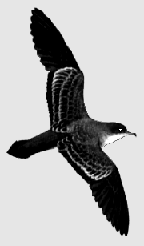Shearwaters
 Medium-sized, shearwaters fly near the surface, hence their name. They
nest on remote islands, often in burrows. They are pelagic, spending most
of their lives at sea, though during breeding season they may remain within
50 miles of their home islands. They take fish and squid at the surface
and may pursue fish for short distances underwater. Various species
include the Streaked, the Sooty, the Pink-Footed, the Flesh-Footed, the
Little, the Giant (as large as an albatross), the
Short-Tailed,
and the Wedge-Tailed.
Medium-sized, shearwaters fly near the surface, hence their name. They
nest on remote islands, often in burrows. They are pelagic, spending most
of their lives at sea, though during breeding season they may remain within
50 miles of their home islands. They take fish and squid at the surface
and may pursue fish for short distances underwater. Various species
include the Streaked, the Sooty, the Pink-Footed, the Flesh-Footed, the
Little, the Giant (as large as an albatross), the
Short-Tailed,
and the Wedge-Tailed.
The 'Ua'u Kani, or Wedge-tailed Shearwater (pictured left), is the most
common tropical shearwater in the North Pacific. In Hawai'i,
the Wedge-tailed Shearwater nests in remote areas like Ka'ena Point on
O'ahu. A state-managed program for trapping cats, mongooses and dogs in
the 23-acre Natural Area Reserve at Ka'ean has led to an increase in
nesting birds; these land mammals are known to eat chicks and eggs of the
shearwater and other nesting seabirds, such as the manu ka'upu, or albatross and the
iwa, or frigate bird. (Bunky Bakutis, "Seabirds thrive after
predator-trapping effort" Honolulu Advertiser Dec. 8, 1996 A23).
 Medium-sized, shearwaters fly near the surface, hence their name. They
nest on remote islands, often in burrows. They are pelagic, spending most
of their lives at sea, though during breeding season they may remain within
50 miles of their home islands. They take fish and squid at the surface
and may pursue fish for short distances underwater. Various species
include the Streaked, the Sooty, the Pink-Footed, the Flesh-Footed, the
Little, the Giant (as large as an albatross), the
Short-Tailed,
and the Wedge-Tailed.
Medium-sized, shearwaters fly near the surface, hence their name. They
nest on remote islands, often in burrows. They are pelagic, spending most
of their lives at sea, though during breeding season they may remain within
50 miles of their home islands. They take fish and squid at the surface
and may pursue fish for short distances underwater. Various species
include the Streaked, the Sooty, the Pink-Footed, the Flesh-Footed, the
Little, the Giant (as large as an albatross), the
Short-Tailed,
and the Wedge-Tailed.